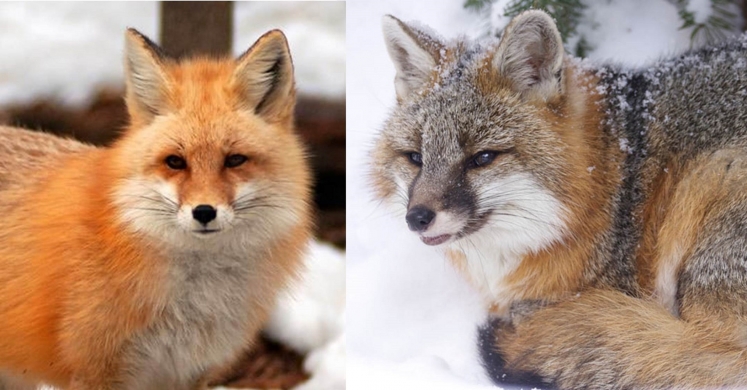Blog

#bioPGH Blog: Red and Gray Foxes
 A resource of Biophilia: Pittsburgh, #bi oPGH is a weekly blog and social media series that aims to encourage both children and adults to reconnect with nature and enjoy what each of our distinctive seasons has to offer.
A resource of Biophilia: Pittsburgh, #bi oPGH is a weekly blog and social media series that aims to encourage both children and adults to reconnect with nature and enjoy what each of our distinctive seasons has to offer.
This week is Valentine’s Day, and love is in the air for more than just humans! If you are just outside the city, and you have heard barking at night that doesn’t quite sound like a domestic dog, then you may be hearing the courtship calls of foxes. February is the breeding season of both red and gray foxes, two of Pennsylvania’s wild canids. They are widespread throughout the state, but they difficult to spot because they are usually quite secretive—let’s explore a bit!
Red and Gray Foxes in Pennsylvania
Both species are elusive and wary of humans, but you may have seen either red foxes (Vulpes vulpes or Vulpes fulva) or gray foxes (Urocyon cinereoargenteus) in the area, particularly at night since they are both nocturnal. They are comparable in size, both weighing 7-13 pounds, but gray foxes are more likely to fall at the extreme ends of this weight spectrum while there is less variability in red fox size here in Pennsylvania (I should clarify, though, that red foxes are found throughout the Northern Hemisphere and can vary in size considerably). Gray foxes are also slightly longer (up to 29 inches) while red foxes are generally only up to 25 inches, but their tails add another foot or more in length! For both species, their names state their most dominant colors, but they have other distinctive markings that differentiate them. Red foxes are…well…red, but they do have black legs and the tips of their ears are black while the very ends of their tails are often white. Gray foxes, on the other hand, are indeed gray bodied, but their faces can include white and red, and the tips of their tails are black. Both species are intelligent, resourceful, and agile hunters; they typically prey on small mammals or birds. However, both are opportunistic consumers (meaning not picky) and they have been known to eat fruits, nuts, eggs, and carcasses. This broad diet has allowed them to adapt to a variety of habitat types across the continent.
In the video below, you can get a good idea of agile these animals are! Perhaps it is not the scientific observation, but you can also note that their kits are quite adorable.
The species also differ in their distribution. While gray foxes are a North American species, red foxes can be found across the Northern Hemisphere. Their Asian counterparts were even the subjects of the famed fox domestication study of the Soviet era. This red fox distribution, though, led to a bit of a mystery of species origins.
The Red Fox Mystery
You may have noticed above that I offered two possible scientific names for red foxes: Vulpes vulpes and Vulpes fulva. Until recently, the origin of red foxes in North America was unclear. Early European settlers did not immediately note the presence of red fox in the eastern US, which fueled the later idea that North American red foxes were descendants of fox farm escapees (farms of European red foxes were common from in the nineteenth and early twentieth centuries). Thus, the idea postulated, red foxes around the Northern Hemisphere could all be the same species, Vulpes vulpes, and their presence in North America could be attributed to human introductions. This idea went back and forth with the notion that North American foxes were indeed here before settlers and deserve their own species name, Vulpes fulva. However, red fox genetics research has recently revealed that the species is genetically distinct from Eurasian red foxes, and that the animals expanded into the continent from Asia during the Pleistocene, when glaciation made intercontinental travel possible. This supports the idea of a separate species, Vulpes fulva here in North America and Vulpes vulpes in Europe and Asia. Granted, there have been some escapees from fox farms, but their swim in the North American gene pool seems to have been very limited. (And because Pittsburgh is awesome, one of our local scientists, Dr. Jan Janecka of Duquesne University was a part of the team of geneticists who helped to solve the red fox genetic mystery!)
Red and gray foxes live all throughout Allegheny County—a few of us even spotted a gray fox behind Phipps Conservatory just last month! Isn’t it exciting to know that whether or not we realize it, we are right in the middle of nature?
Connecting to the Outdoors Tip: You are most likely to see foxes in the evening around dusk or at night, but they are difficult to spot. Keep a listen out through this month, though, as their breeding season continues!
Continue the Conversation: Share your nature discoveries with our community by posting to Twitter and Instagram with hashtag #bioPGH, and R.S.V.P. to attend our next Biophilia: Pittsburgh meeting.
Resources
Pennsylvania Game Commission – Foxes Wildlife Note
Images: Red fox, New Jersey Division of Fish and Wildlife; Gray fox, Vermont Fish and Wildlife Department

